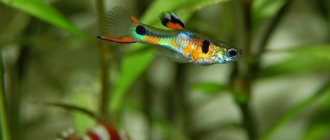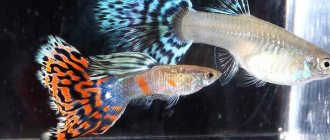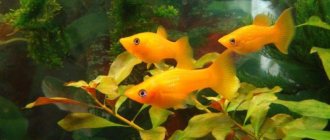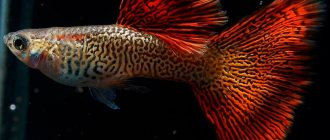How to tell if a guppy is pregnant
Guppies are viviparous fish with internal fertilization. Sexual maturity in females occurs at 3-4 months. Males begin to court a sexually mature female. After fertilization, the female stops admitting males, and soon the first signs of pregnancy appear.
Many novice aquarists do not know what pregnant guppies look like, and may confuse the fish’s pregnancy with overeating. Determining if a guppy is pregnant is quite simple. The female's abdomen takes on a rounded shape and begins to protrude from the sides. Over time, it becomes rectangular - a “step” appears in front of the anal fin. The head of a pregnant female looks slimmer due to the enlarged belly. When overeating, the fish's belly increases only in the lower part, and its shape remains round.
Another sure sign that the female has become pregnant is the presence of a dark spot in the lower part of the abdomen near the anal fin. At the beginning of the period it is small and implicitly expressed. As the offspring develop, the spot enlarges and becomes darker. However, you should not judge the pregnancy of a guppy by just one spot. In some species it may be absent or subtle, in others it may be present in non-pregnant fish. Therefore, a conclusion about the presence or absence of pregnancy is made based on several signs.
Other livebearers
For a long time, the phenomenon of viviparous fish was associated exclusively with guppies. This mystery haunted naturalists. But today aquariums are inhabited by many other species of viviparous fish, for example:
- sword bearer
- Pecilia
- Mollies
- Formosa
- Ghirardinus
- Xenotoka
- Limia
- Half-snout
- Iliodon
- Ameka.
The Fishes in the Bank wish you success in breeding guppies and perhaps you will be the one to breed your own form!
Fertilization process
Sperm are introduced into the female's genital opening using the gonopodium. The formation of the copulation organ begins during puberty. Before this, there are no differences in the structure of the anal fin of the female and the male. With the onset of puberty, the rays in cross-section resemble a triangle, and later a tube.
The tube, equipped with muscle fibers, rises or falls, which facilitates the introduction of spermatophores - “packets” of sperm into the female’s body. They are partially spent on fertilizing part of the eggs, and a certain amount of seed material is stored inside the reproductive organs of the female for several months. In guppies, as a result of one insemination, from 5-6 to 11 marks often occur.
When the female is completely ready to mate, she releases a special secret into the environment that attracts males to her. They also have a chemical effect on the mating behavior of females. Copulin secreted by the gonads of males forces the female to take a position that is most convenient for inserting the gonopodium into the genital opening. The female's swimming in an inclined position is another sign of her readiness for copulation.
But such chemical “markers” of readiness for procreation do not replace physical stimulation. The male begins a courtship dance around the female, spreading his fins and sparkling with the bright color of his body, he quickly rushes around the chosen one. Several males can “chase” a female at once.
Interestingly, each male has his own dance, which he repeats in great detail during each mating. This mating ritual is enshrined in the genetic memory of males. If he does not “court,” the female will not allow the male to approach her, despite the chemical marks.
The female also chooses a “gentleman” based on the brightness of the color and the length of the fins. The winners are males with red coloring or red spots and long fins. They grow in males throughout their lives and indicate longevity and good health. These qualities are desirable in offspring. Thus, information about his viability as the father of numerous offspring is “encoded” in the male’s appearance.
Features of reproduction
For guppies, the process of reproduction in an aquarium is no different from reproduction in nature. Viviparity in fish is not very rare, but has nothing in common with bearing young in mammals. The only difference between viviparous and egg-laying species is that the eggs do not fall into the water, but develop in the body of the female. When the baby guppies are ready to hatch, they leave the egg shell and exit through the mother's anus.
How does fertilization occur?
During the spawning of egg-laying fish, the male releases milt into the water, and sperm penetrate the eggs. But this method is not suitable for fertilizing eggs in the belly of a female of viviparous breeds. Mating occurs through a special organ of the male - the gonopodium. It is a modified anal fin that is mobile and can take different positions. The male introduces milk into the anus of the female, and fertilization of the eggs occurs in the cavity of her body.
Guppy spawning looks like a game or fight between a male and a female. The female takes a special pose, bending her torso. The male swims around her, rubs and presses against the female's body. The moment of fertilization is difficult to notice; it occurs within 1-2 seconds. After this, he does not take part in the development of eggs and caring for his partner. A pregnant guppy behaves the same way as before spawning.
Why don't guppies reproduce?
Beginning aquarists often have questions about how to breed fish, how to determine pregnancy in livebearers, and how to know that a fish is about to give birth. But people often ask why they can’t get offspring. There may be several reasons:
- Absence of males in the flock. Modern breeds of guppies imply the presence of a beautiful tail in females. You can accurately determine the sex of a fish by the shape of the anal fin: in males it is thin and long, and in females it is round.
- Lack of space in the aquarium. This unpretentious fish is sensitive to water volume. If there is less than 3 liters of volume per pair, then the pets will not mate. When determining the volume, you need to take into account how many fish of other varieties live in the general aquarium.
- Other errors in content. Fish do not reproduce well at low temperatures in the aquarium (less than +22°C), rarely replacing part of the water, or overfeeding. Breeding guppies requires compliance with the necessary water parameters and basic care rules.
Sometimes the only reason for the absence of fry is the inattention of the owner: he simply does not notice how his pets mate and give birth. If this happens in a community aquarium, the small individuals are eaten by other fish.
To achieve offspring, you need to know how often guppies give birth, how to distinguish a pregnant female, how she behaves if she is about to give birth, and when to separate her from the rest of the inhabitants.
How to establish pregnancy
The expert will not only understand at first glance that the female is pregnant, but will also set a fairly accurate date. A beginner just has to learn this. First of all, pay attention to the external signs of the fish. Usually slender and even thin, it suddenly begins to “put on weight” - the abdomen becomes noticeably rounded, which is why the body loses its streamlined shape, the fish becomes slower and clumsier.
At the same time, a dark spot appears near the anus, which grows over time. A few days before birth, with good lighting and a good location of the fry, you can even see their eyes.
Pregnancy usually lasts 22-26 days. But in some cases this period increases to 35 or even 40 days - stress, unsuitable temperature or illness have an effect.
Now you know what a pregnant guppy looks like before giving birth, and you can take care of her. Once the spot is dark enough, you should be prepared for the fry to appear any day now.
Read also: The Dark Brotherhood is forever in Skyrim
Raising young animals
The fry are born completely independent and immediately begin to swim.
After giving birth, the mother must be removed from the nursery. And plant an aquatic plant, for example, elodea, at the bottom of it, pressing it down with a stone. Duckweed or riccia should be placed on the surface of the water. This is how shelters are prepared for young animals.
Malek guppy
The optimal size is about 5 liters for spawning. A day after birth, the fry must be transplanted into a large container with a volume of 20-40 liters.
The temperature in the water incubator must be maintained at an optimal temperature. Reducing it to +18 °C leads to the fact that guppies grow slowly and their color does not reach full colors. And excessively warm water (+30…+35 °C) significantly accelerates the formation of fry, but at the same time their fins do not have time to fully form and do not reach the desired size and shape.
Inside the mother, the embryos, like all fish, feed from the yolk sac, and 2-3 hours after birth the fry can already eat food on their own.
Lighting should be removed for the first 3-5 days, during which time the babies are even fed in the twilight. The number of feedings per day is up to 5 times.
For the first feeding, only live food is used - Cyclops crustaceans, Artemidia nauplii, rotifers. A little later, you can diversify the diet with ready-made tablets for fry, for example, MicroMin and TetraOvin.
As a last resort, in the absence of live food, you can prepare a mixture of curdled milk, egg yolk, omelet, cheese and milk powder. All products are crushed, mixed with water from the spawning tank and poured into the tank for the fry.
In the case of breeding work, at 2-3 weeks the young animals are sorted by gender.
Pairing
Mating of guppies occurs frequently, provided there are satisfactory conditions in the aquarium. These fish reach sexual maturity at the age of 3-4 months. By this time, the sexual dimorphism of the guppies is clearly pronounced and noticeable even to a beginner. And it won’t be difficult to determine where the male is and where the female is.
Thanks to the gonopodium, a pointed tube-shaped anal fin transformed into a sexual organ, the male injects milk directly into the female’s body.
It is interesting that, having mated once with a male, the female can use his seed for self-fertilization several more times!
Avoiding cannibalism
These aquarium fish, unlike others, lack maternal instinct. Guppies are cannibal fish, so after giving birth, the female can safely eat her offspring. To avoid this situation, after birth it is worth separating the fry from the mother, if the spawning took place in a separate vessel. Special internal aquarium tanks are organized. If spawning took place in an aquarium with other fish, you should provide the fry with places where they can hide from large individuals: add various algae, driftwood, and stones to the aquarium.
With good and sufficient nutrition, you can completely wean guppies from cannibalism.
The fish reach sexual maturity at the age of 4-5 months.
Behavior before childbirth
From external signs - at some point the fish’s belly becomes rectangular. Loss of appetite is also a signal that the fish will give birth soon. Also, before giving birth, the guppy trembles and tries to hide in shelters or algae, preferring shaded places. If there is a heater in the aquarium, the fish will lie next to it or prefer to sit on the bottom.
When to Jigging
Before giving birth, the female guppy should be placed in another container to ensure her peace of mind and create conditions for the successful birth of offspring. Temporary relocation will also help protect the fry from being eaten by other fish species. There is no need to remove the fish if there are no signs of imminent labor. A change in habitat brings more stress to the expectant mother, for this reason the aquarist must ensure that the fish stays separately for as short a period of time as possible.
If the female cannot give birth
There are cases when the time of birth for a gupeshka should already be approaching by all calculations, but it is not. There may be several options for the development of events. Perhaps there was an error in the calculations and you need to wait a little longer, or maybe the fish cannot be born. In this case, you can speed up the onset of labor by changing the water temperature. You just need to increase it by 2 degrees and the process should go faster. For stimulation, a 20-30% water change will be sufficient. It is important not to sharply increase the temperature, otherwise the birth may be premature; unfortunately, in this case, all the offspring may die, becoming unviable . There is another way that will help if the guppy cannot give birth, this is to add a young male to the female. As soon as labor begins, he will need to be placed in another container.
Guppies' labor lasts differently, it can be one hour, or it can be 12 hours. And she can throw out the fry in batches. Several pieces each. The frequency of release of such batches may vary; we must remember that everything is individual. As a rule, guppy fish give birth to the next batch of fry within a month or two. In this case, you need to think about where all this numerous offspring will live.
How long does a guppy's pregnancy last?
Guppy pregnancy lasts on average 21-24 days. There are known cases when the duration of gestation was 42 days. The duration of pregnancy is influenced by the following factors:
- age of the fish;
- her state of health;
- stress;
- water temperature;
- conditions of detention;
- feeding.
When the fish is kept in poor conditions, in the presence of stress and inadequate feeding, the gestation period increases. Diseases slow down the development of eggs, and in some cases can cause miscarriages and miscarriages. In young fish, pregnancy lasts longer than in older guppies. A slight increase in water temperature (up to 24-26°C) accelerates the development of eggs. Severe stress can trigger premature birth. Fry born prematurely, as a rule, do not survive.
Readiness of fish for fertilization
When breeding purebred guppies or engaging in selection, it is necessary to strictly monitor the crossing of fish and correctly form pairs. And to do this, you need to determine in time the guppies’ readiness for mating.
A sign of readiness for the mating process in guppies is courtship. The male begins to “chase” the chosen one, pressing against her side with his anal fin. At this point, the aquarist must isolate the couple, since the fertilization process has already begun. In the future, placing a pregnant female in a separate vessel can be dangerous for her and her offspring, since she becomes very sensitive to changes in environmental characteristics.
These unpretentious fish can breed in a small container, but the better the conditions, the healthier and larger offspring you can get. The “maternity hospital” should have enough space for 2 guppies. Experienced aquarists claim that from the moment the couple is isolated, the female’s pregnancy can be counted. Very rarely, a male may need 2-4 days for fertilization.
Depending on age, number of previous marks, water temperature, type of food and other characteristics, the duration of the gestation period can vary from 30 to 60 days. Normally, the period is 30 ± 5 days. A reduction or increase in gestational age may indicate a violation of the conditions of detention or problems with the health of the fish. The interval between litters can be 1-2 months.
A special feature of the livebearers is that the mark is extended over time. A fertilized fish can “give birth” to fry in groups with a time gap between births. Sometimes another male mates with the female who gave birth, and in the next generation babies will appear from both males.
Pet mating conditions
A three-liter glass jar is suitable for equipping a spawning tank. Fresh, settled water is poured into it (temperature 23-27 degrees), stones are placed, and algae is planted. Then a male and a female are placed there. To speed up the process, the temperature of the aquarium water is raised by 4 degrees. You can determine the beginning of mating by how the males begin to chase the females.
The male fertilizes the fish using the genital organ - the gonopodium. The organ is formed only in individuals that have reached sexual maturity. The gonopodium has the shape of a fin with several tube-shaped processes.
If breeding takes place in an aquarium with other fish, then make sure that there are not a large number of males there. They can chase the poor fish to the point of exhaustion or even death. If you notice that one of the males is showing interest in the female, it is better to place the pair in another container. After mating, return the fish to the community aquarium, where the female will live until she gives birth.
How to preserve offspring?
The problem of how to care for fry after birth ranks first among beginners' questions. Reproduction of fish will bring pleasure only if you manage to raise the resulting young fish. The most difficult thing is to understand what to feed the fry in the first days. In order for them to grow faster and develop properly, feeding begins from the first day. It is better to take care of food in advance:
- purchase ready-made starter feed in the store;
- breed food organisms yourself;
- Keep the aquarium with the fry in the light so that green algae grows on the walls.
The fry receive everything that is necessary for the growth of young fish with food. Experienced breeders who take care of the selectively bred offspring they need, raise ciliates to feed the fry.
This food is sold under the name live dust. The water containing the microscopic creatures is pipetted into the spawning tank. At first, the fry are able to eat only such small food and algae from the walls of the aquarium. As they grow, the fry's diet includes live crustaceans:
- Artemia nauplii;
- daphnia;
- Cyclops.
In addition to live fish, they are also given concentrated food for fry (colored flakes). Growing fish are fed increasingly larger foods (tubifex, scraped meat, granulated concentrates). The size, richness of color, and good appearance of adults depend on how to feed the fry at an early age.
Care and maintenance of fry
Caring for the fry also includes maintaining a favorable environment in an artificial reservoir. To correct the temperature, a water heater with a thermostat is used. To saturate the water with oxygen, turn on the aerator. The nursery aquarium must have a filter.
In addition to technical devices, the owner must also take care of the quality of water. 1-2 times a week, the bottom is cleaned with a siphon, collecting waste from the juveniles. When cleaning, be careful not to get fish into the siphon. After cleaning, with which 1/3 of the liquid volume is drained from the aquarium, fill it to the previous level with clean, settled water.
Determining the sex of the fry
Another important question is how to determine the sex of born fish, how to understand who is more numerous in the school. Young fish look the same, and become different at the age of 2-3 months. They are already large enough for the owner to see the gonopodium of males. The color and size of the tail of males are also sexual characteristics, but modern breeds, which even beginners prefer to raise, often do not have pronounced differences.
When the sex is determined, it is advisable to separate the young females from the males and raise them separately. If you are not engaged in selective breeding, plant the young animals in a common acarium as a whole flock.
Caring for fish after birth
A guppy that has given birth looks exhausted and exhausted; it is useful to keep it in a cage in an aquarium for some time, without allowing males to approach it. She can give birth to fry again in a couple of months.
In winter, it is useful to give the fish a break from breeding by reducing the water temperature and the duration of lighting.
Multi-colored viviparous guppies are very attractive due to their ease of keeping. Even a child will be able to care for and breed nimble fish. Watching reproduction, monitoring the growth of fry, feeding and caring for them is a very exciting and useful activity.
With full confidence, we can advise getting guppy fish to those who are taking their first steps in understanding this fascinating activity - home aquarium keeping.
is an unpretentious viviparous freshwater fish from the Poeciliaceae family. It is the most popular and unpretentious of all aquarium fish, which means every breeder should know what a pregnant female guppy looks like. This will help to create the necessary conditions for the pregnant female in a timely manner.
How do you know if a guppy is pregnant?
The shape of the abdomen will indicate whether the guppy is pregnant. The expectant mother has a round, voluminous abdomen, which becomes slightly rectangular before giving birth. Through the gaps you can sometimes see the fry, and closer to birth, the guppy's birthmark on the abdomen darkens. The shape of the head begins to appear graceful due to the voluminous belly. The fish behaves calmly and peacefully.
Taking into account all the listed signs, you can understand that the female is pregnant and prepare in advance for childbirth.
When to wean a pregnant guppy?
In females, before throwing fry, the back of the belly always darkens. If only guppies live in the aquarium, and there are a lot of shelters (snags, stones, algae), you don’t have to remove the female; some of the fry will still survive. But when there are other fish in the aquarium, the pregnant guppy must be removed while it is throwing, and then brought back in after that. The fry are raised in a separate container. You need to put a stocking on the internal filter, and a foam rubber prefilter on the external filter so that the fry do not get sucked in.
When placing a pregnant guppy, remember that she can also eat her fry, so prepare where they will hide while the mother is with them. The number of fry born to a female guppy depends on her age. A very young guppy can give birth to 10 fish, and an old one - up to a hundred fish. Newborns should be fed immediately, three times a day in small portions. In order for the fry to grow quickly and have beautiful colors, they must eat a variety of foods.
How long does a guppy's pregnancy last?
Guppy pregnancy lasts 30-40 days. During the first week, the fry sit in the hatchery, where they were born. From the second week they can be transplanted into larger containers.
In a month, differences between the female and the male become noticeable. In females, a birthmark appears - a darkening near the anus, but in light-colored breeds it is difficult to distinguish. In males, at 2-3 months, the anal fin changes, it turns into a gonopodium.
If you want to avoid the reproduction of guppies, the juveniles must be promptly divided by gender and kept separately. By maintaining the water temperature within +18°C in winter, you will prevent unnecessary spawning and allow the female to take a break from giving birth.
According to many aquarists, guppies are one of the most prolific aquarium fish. This is due to its unpretentiousness and easy adaptability. Another plus for increased fertility is live birth. Thus, the risk of damage to the eggs is minimized.
What else is important to know?
Guppies are very beautiful and viviparous aquarium fish. There are practically no problems with their reproduction. But in order to regularly produce strong and healthy offspring, they need to be provided with optimal conditions.
Puberty
Females quickly become ready for pregnancy. Full puberty occurs at approximately 2-3 months of age. This is the optimal period when the female is ready for fertilization and can produce strong offspring.
Spawning, aquarium preparation
Guppies do not require any special conditions. To stimulate spawning, it is enough to slightly raise the temperature or refresh the water in the aquarium by adding fresh water.
To reproduce guppies, one male and 3-5 females are enough.
An aquarium with a lot of greenery must be prepared for the fry, where they can hide. Inbreeding should not be allowed, as the offspring may develop various pathologies and external defects. Therefore, guppies need to be bred with special attention.
Fry
There are some characteristics of young offspring that are worth knowing. Namely:
- guppies are born very small and difficult to see, as they have a grayish and translucent color;
- the fry are transplanted into a common aquarium after they have grown a little, so that other fish do not eat them;
- the fry grow actively and at the age of 30-40 days acquire an “adult” coloration; at this age they can be transplanted from the spawning tank to a larger container;
- feed the young animals small food so that they can swallow it.
Pregnancy in guppy fish
The temperature of the habitat should not exceed 26 degrees. If a pregnant female senses any danger, the birth may be delayed indefinitely. Too high a stress threshold can lead to spontaneous miscarriage. Therefore, it is important not only to detect pregnancy in a guppy in time, but also to create appropriate conditions for caring for her during the period of gestation:
- Monitor the water temperature.
- Change the water on time, clean it of excess food or its residues.
- Adjust the presence and level of ammonia in the water.
Spawning tray for breeding aquarium fish.
If she gets sick, it will definitely affect her offspring. It is advisable to feed her with live food, this will protect her body, prevent deformation of the fry, and maintain pregnancy . Live food contains a lot of protein, and it has a beneficial effect on both the condition of the female and the health of the fry.
If possible, purchase a special tray for pregnant fish. It is attached to the aquarium (inside) and serves as a secluded place for the pregnant fish, without depriving it of its usual environment. Without creating unnecessary stress. If this is not possible, then you can divide the aquarium with a fine grid, so she will feel calm and the males will not chase the pregnant guppy.
Guppies do not reproduce: reasons
These aquarium fish reproduce very well, but sometimes it happens that they do not want to have offspring.
Reasons why guppies do not reproduce:
- unfavorable conditions for reproduction;
- the fish are under severe stress;
- guppies bring fry, but they are immediately eaten by adult fish;
- insufficient or excessive feeding (the fish become fat and infertile);
- all individuals in the aquarium are of the same sex.
Breeding guppies is a fun activity. They breed easily and grow quickly. You can admire the fish or carry out selection, selecting pairs with certain characteristics and obtaining fry with the desired characteristics.
How do guppies mate?
You will immediately notice if the fish begin their mating season. During this period of time they move faster than usual. Males actively pursue the female and approach her from the side or below. It is important to take into account that there should be fewer males than females, otherwise the males can drive the female to death. That is, for one male there must be at least 2 females.
Guppy mating itself occurs with the help of a movable anal fin in the form of a tube in the male, which is called “gonopodium”. Fertilization occurs in the female's abdominal cavity, where seminal fluid penetrates. Afterwards, it is stored in the mother’s body for a long time, so the female can be fertilized several more times without the presence of a male.
Reviews
Guppies are beautiful and unpretentious aquarium fish; it is a pleasure to breed them and watch them. With proper and successful breeding of guppies, it is possible to carry out selection work, obtaining specimens of a pure breed with an interesting color and original hybrids by crossing with other species. But if you want such results, you need to understand how they reproduce and monitor it. Responsibility for overpopulation or death of fish lies entirely on the shoulders of the owner. By the way, their health also needs to be carefully monitored, because guppies do not always tolerate diseases well, but this is a topic for another article.
Would you like to buy a Guppy for your own aquarium? Share in the comments!
Postpartum behavior
Even the mother guppy can eat her offspring during spawning. After giving birth, the female should be returned to the general aquarium, and the fry should be left in the container until maturity. You can also protect them from their mother using a special partition.
There is no need to worry about separating the fish: they are designed in such a way that they do not need parental care and from the moment of birth they are able to feed and survive independently.
It is known that a female is able to become pregnant even an hour after giving birth, but more often the next offspring appears after 1–2 months. Females are able to give birth up to 8 times, being fertilized by one male, or can mate with others, producing a variety of offspring.
Organization of spawning
As a spawning tank, you can use a small aquarium with a volume of 4-5 liters or a regular three-liter jar. To prevent the female from eating the newborn larvae, Java moss, elodea or other plants must be attached to the bottom of the container. Then the fry will fall down and hide in the thickets. Childbirth can also take place in a community aquarium , provided that only guppies live there and there is enough shelter and vegetation.
The birth itself lasts several hours. During this time, the fish gives birth to an average of 50 larvae, but the count can go into hundreds. A young female brings 10 fry , and with age, her fertility increases several times.
After spawning, the adult is placed back in the aquarium. If the guppy lives in favorable conditions and eats well, a new pregnancy can occur within a few hours.











